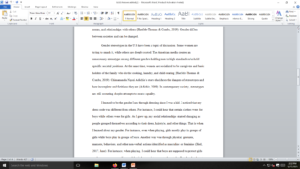Biological sex and gender
The resources this week ask you to consider the concept of gender in the US and how gender categories are constructed. They also introduce you to gender constructions outside of our binary (man/woman; male/female) gender system. Please use and cite at least 2 of the required resources as you respond to the following questions:
- What is the difference between biological sex and gender?
- What are some of the “single stories” (Aidichie, 2009) that people in the US have about men and women? In other words, what are the stereotypical gender roles in the US?
- How did you learn how to be the gender that you are? Provide at least 3 examples.
- How do people in the US treat people who don’t “fit in” to gender roles? How might this relate to the treatment of transgender, non-binary, genderqueer, and other individuals?
Your initial post should be at least 300 words in length, excluding the discussion prompt and the references. Please use in-text APA citations within your post as well as full APA references at the end of your post.
Requirements: 300 words or more
Answer preview
I learned to be the gender I am through dressing since I was a kid. I noticed that my dress code was different from others. For instance, I could hear that certain clothes were for boys while others were for girls. As I grew up, my social relationships started changing as people grouped themselves according to their dress, hairstyle, and other things. That is when I learned about my gender. For instance, even when playing, girls mostly play in groups of girls while boys play in groups of boys. Another way was through physical gestures, manners, behaviors, and other non-verbal actions identified as masculine or feminine (Bird, 2017, June). For instance, when playing, I could hear that boys are supposed to protect girls are boys are more masculine, and that is how society expects them to be. People who do not
[427 Words]

Biological sex and gender

